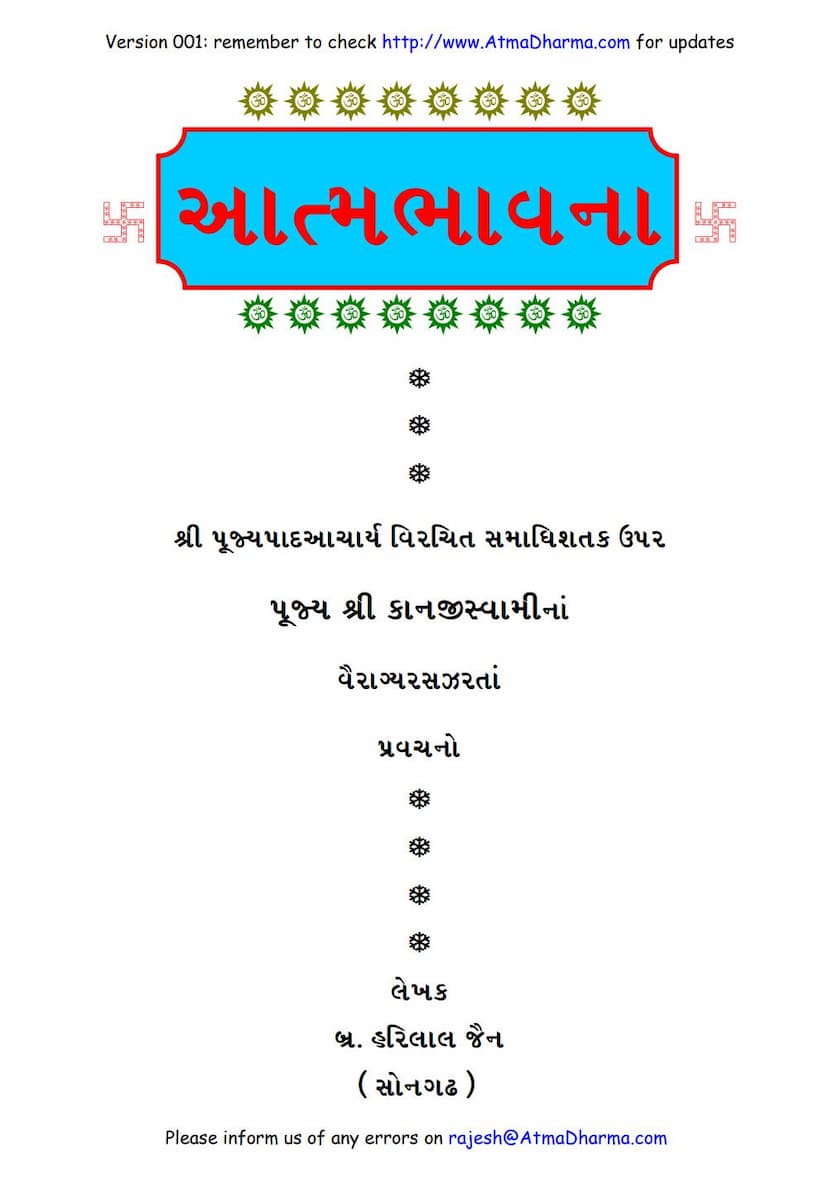Atma Bhavna
Added to library: September 1, 2025

Summary
The book "Atma Bhavna" (Soul Contemplation) is a collection of discourses by Pujya Shri Kanji Swami, based on the "Samadhi Shatak" (Century on Equanimity/Samadhi) composed by Pujya Acharya Shrimad Pujyapada Swami. The discourses were compiled by Brahmachari Harilal Jain.
The book's central theme revolves around achieving spiritual liberation and inner peace by understanding and contemplating the true nature of the soul (Atman). It emphasizes the Jain philosophy of Ahimsa (non-violence) and Anekantavada (non-absolutism) as a path to spiritual realization.
Here's a breakdown of the key concepts and themes presented in the text:
1. The True Nature of the Soul:
- The soul (Atman) is described as pure, conscious, blissful, and eternal, distinct from the physical body, senses, and emotions.
- It is the true self, characterized by infinite knowledge, perception, bliss, and power.
- The soul is the ultimate reality and the only source of true happiness and peace.
2. The Problem of Ignorance and Attachment:
- The soul's suffering and bondage in the cycle of birth and death (samsara) are attributed to ignorance (avidya) and attachment (raga) to the non-soul (body, senses, emotions, external objects).
- The false identification of the self with the body and its transient states (birth, death, emotions) is the root cause of suffering. This is the state of Bahir-atma (external soul or soul identified with the external).
3. The Path to Liberation (Moksha):
- Ahimsa and Non-violence: The text implicitly and explicitly stresses the importance of Ahimsa, not just in action but also in thought and speech.
- Bhed Gyan (Discrimination): A core concept is the ability to discriminate between the soul (Atman) and the non-soul (pudgala, karma, body, emotions). This discrimination is crucial for detaching from the transient and realizing the eternal.
- Samadhi (Equanimity/Inner Peace): The path to liberation is through achieving Samadhi, which is the state of unwavering equanimity and absorption in the true nature of the soul.
- Aparigraha (Non-possession): Detachment from external possessions, including bodily states and sensory pleasures, is essential.
- Vairagya (Renunciation): Cultivating a sense of detachment from worldly pleasures and attachments is a key practice.
- Shubha Bhavna & Shuddha Bhavna: The text differentiates between virtuous thoughts (Shubha Bhavna) and pure soul contemplation (Shuddha Bhavna). While virtuous thoughts are a step, the ultimate goal is the contemplation of the pure soul.
- The Role of Knowledge: True knowledge (Jnana) is not just intellectual understanding but the direct realization of the soul's nature. This knowledge, when consistently contemplated, leads to liberation.
- The Three Stages of the Soul:
- Bahir-atma: The soul identified with the external world and the body.
- Antar-atma: The soul that has begun to discriminate and turn inwards towards its true nature.
- Param-atma: The soul that has realized its pure, liberated state, free from all karmic bondage.
- Self-Reliance: The ultimate path to liberation is through one's own self-effort and introspection. While external guidance (gurus, scriptures) is helpful, the soul's liberation is ultimately an internal realization.
4. Key Practices and Concepts:
- Aparigraha: Non-attachment to possessions, including the body and its states.
- Vairagya: Renunciation and detachment from worldly pleasures.
- Bhed Gyan: The crucial practice of discriminating between the soul and non-soul.
- Ahimsa: Non-violence in thought, word, and deed.
- Self-Contemplation (Atma Bhavna): The core practice of continuously reflecting on the soul's true nature, its eternality, purity, and bliss.
- Samadhi: Achieving a state of undisturbed equanimity and absorption in the soul.
- Vitaragta: Freedom from attachment and aversion.
5. The Example of Siddhas and Arihants:
- The liberated souls (Siddhas) and the enlightened ones who have attained omniscience and are still embodied (Arihants) serve as the highest ideals and examples. Their state of pure consciousness and bliss is the ultimate goal.
6. The Importance of Right Faith, Knowledge, and Conduct (Ratnatraya):
- The text implicitly underscores the Jain path of Right Faith (Samyak Darshan), Right Knowledge (Samyak Jnana), and Right Conduct (Samyak Charitra) as the means to achieve the soul's true nature and attain liberation.
Overall Message: The book "Atma Bhavna" guides the reader towards self-realization through introspection and the constant contemplation of the soul's true, eternal, and pure nature. It advocates for detachment from the external world and the development of inner peace and equanimity, ultimately leading to the state of liberation (Moksha). The teachings are presented in a way that encourages diligent effort and unwavering focus on the soul as the sole source of lasting happiness.